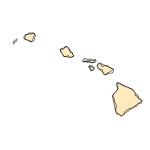Poeciliopsis sp.
(unidentified Poeciliopsis)
Fishes
Native Transplant |
|
Common name: unidentified Poeciliopsis
Synonyms and Other Names: livebearer, topminnow.
Taxonomy: available through
www.itis.gov
Identification: Rauchenberger (1989b) listed 20 extant species in the genus Poeciliopsis. Rosen and Bailey (1963) provided diagnostic characters of the genus and a limited amount of information on the species known at that time. Distinguishing characteristics for species previously found in the United States were given by Page and Burr (1991). Photographs of several species appeared in Dawes (1991) and Wischnath (1993).
Size: 5.1-6 cm.
Native Range: Members of the genus Poeciliopsis occur in Pacific drainages from the southwestern United States to Colombia and in some Atlantic streams of southeastern Mexico, Guatemala, and Honduras (Rosen and Bailey 1963). Only one species, P. occidentalis, is native to the United States where it occurs in the Gila River system, New Mexico and Arizona, and in western Mexico; now extirpated in New Mexico (Page and Burr 1991).



|

Alaska |

Hawaii |

Puerto Rico &
Virgin Islands |

Guam Saipan |
Hydrologic Unit Codes (HUCs) Explained
Interactive maps: Point Distribution Maps
Nonindigenous Occurrences:
Table 1. States with nonindigenous occurrences, the earliest and latest observations in each state, and the tally and names of HUCs with observations†. Names and dates are hyperlinked to their relevant specimen records. The list of references for all nonindigenous occurrences of Poeciliopsis sp. are found here.
Table last updated 12/14/2025
† Populations may not be currently present.
Means of Introduction: Unknown. Possible aquarium release.
Status: Preumably failed in Connecticut.
Impact of Introduction: The impacts of this species are currently unknown, as no studies have been done to determine how it has affected ecosystems in the invaded range. The absence of data does not equate to lack of effects. It does, however, mean that research is required to evaluate effects before conclusions can be made.
References: (click for full references)
Dawes, J.A. 1991. Livebearing fishes. A guide to their aquarium care, biology and classification. Blandforn, London, England.
Page, L. M., and B. M. Burr. 1991. A field guide to freshwater fishes of North America north of Mexico. The Peterson Field Guide Series, volume 42. Houghton Mifflin Company, Boston, MA.
Whitworth, W. R. 1996. Freshwater Fishes of Connecticut. State Geological and Natural History Survey of Connecticut, Bulletin 114.
Other Resources:
FishBase Summary
Author:
Nico, L.
Revision Date: 5/9/2019
Peer Review Date: 8/29/2001
Citation Information:
Nico, L., 2025, Poeciliopsis sp. Regan, 1913: U.S. Geological Survey, Nonindigenous Aquatic Species Database, Gainesville, FL, https://nas.er.usgs.gov/queries/FactSheet.aspx?SpeciesID=867, Revision Date: 5/9/2019, Peer Review Date: 8/29/2001, Access Date: 12/15/2025
This information is preliminary or provisional and is subject to revision. It is being provided to meet the need for timely best science. The information has not received final approval by the U.S. Geological Survey (USGS) and is provided on the condition that neither the USGS nor the U.S. Government shall be held liable for any damages resulting from the authorized or unauthorized use of the information.